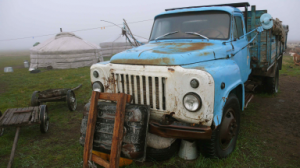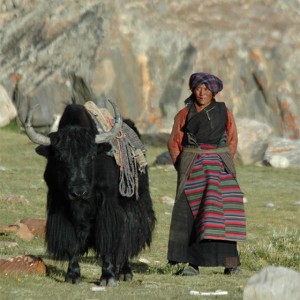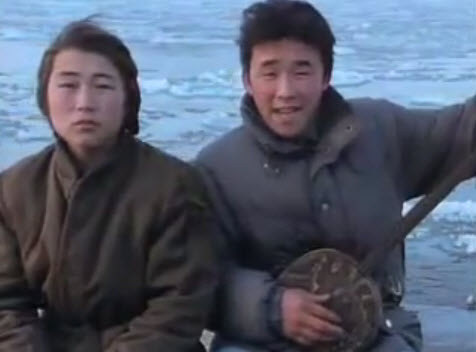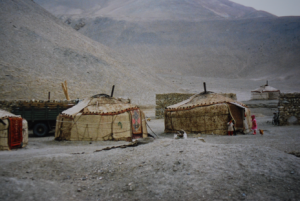Two cool cats doing their Mongolian Throat Singing thing.
I guess everyone knows that Mongolian throat singing is a style in which two or more pitches sound simultaneously over a fundamental pitch, producing a unique and vibrating sound. And I guess most people also know that the singer does this by manipulating the resonances which are created as air travels from the lungs past the vocal folds and out the lips to produce a melody.
You may be as surprised as I was to learn that when people speak of Mongolian throat singing, they probably mean Tuvan throat singing. Tuva just doesn’t get its just due. It’s a proud republic of good old Mother Russia to the west ofMongolia. So one can empathize with the neglect those Tuvans must feel when everyone just lumps them as satellite ofMongolia. But apparently those who distinguish between the finer nuances of Mongolian and Tuvan throat singing spend more time kayaking on icy rivers than surfing the internet, because I couldn’t find a single coherent explanation of the difference between them. So I’ll just stick with my unfortunate fuzzy preconceptions.
Mongolian throat singing has enjoyed quite a fad in the West in recent years. Here’s Bela Fleck covering one of Tuva’s Greatest Hits, ‘Alash Khem’, with the help of a guest throat singer who looks like he’s having a very good time up there. But we all know that that his kimono was made in Honduras, because the guy’s wearing an ear monitor. Still, he seems like a very good-natured guy. So here’s what appears to me to be the real thing, as far as I can figure it out (which admittedly ain’t too far) – two ultra-cool dudes flashing their chops (somewhat literally) while they’re watching the river flow (wholly literally).
I don’t mean to leap into stereotyping Southern Central Asians, but they seem like a very cheerful sort of folk. It could be that my attitudes are colored by a story a guy named NM. once told me:
While I was hitch-hiking across Siberia in 1992, on my way from Novosibirsk to Kamchatka, I decided to take a detour through Mongolia. I really wanted to see a Bactrian (two-humped) camel. There aren’t many roads in rural Mongolia. Just lots of steppes. There are trails, but they’re more recommendations than proscribed paths. You just pick a direction and go. Which is what I was doing when this little old truck came along. I flagged it down. Folks didn’t see a lot of occidentals out there, let alone backpackers, so I guess I might have looked rather strange to them. Anyway, they did stop the truck, and I asked them where they were going. They smilingly told me their destination was a town (the demographic definition of a town in those parts is at least three yurts and two yaks) vaguely in my direction, about eight hours by steppe path. So I asked if I could travel with them. I told them I’d give them money for gas, and they smilingly agreed.

(L to R) Yurt, truck
I tossed my backpack in the back of the truck and climbed in. There was Pa Enkhbayar, Ma Enkhbayar, and three little Enkhbayars.
JM: How did you communicate?
NM: A little bit of Russian, a little bit of Chinese. Not a problem.
So we were rolling along, having a real good time. I was juggling for the little Enkhbayars, which kept them out of their parents hair for a while. After a few steppey hours, we came upon a nicely decked-out yurt. Pa Enkhbayar suggested we stop for a break and a repast, and I readily agreed. The hosts seemed rather nonplussed by our unannounced visit, despite the fact that there didn’t seem to be much traffic of locals on that particular steppe, let alone waigouren (foreigner) hitch-hikers.

(L to R) Yurt, horizon
They graciously asked us into their yurt. Before we sat down to eat, they showed me how to wash my hands in the traditional fashion. You fill your mouth with water from a canteen, yak-gut I think, then gradually release a stream of water onto your hands, rubbing them together. It works pretty well, actually. Then we sat down to eat.
JM: What was on the menu?
NM: Oh, I don’t think you want to know that.
Anyway, after the meal, they asked me if I’d like to play a game. “当然”, I said, and they brought out the paraphernalia from under the yak-hair mat. It consisted of a board; a long, narrow strip of handwritten paper with symbols and numbers, and four yak molars. They explained to me that each molar (right upper, right lower, you get the idea) had six faces (a small stretch of the imagination), each with its own unique shape which (to them) resembled another animal (dog, Bactrian camel, yak, you get the idea). I had a hard time discerning that. They explained that each participant in his turn rolls the molars, and according to the way they land, you consult the list of possibilities (dog-dog-yak-camel, for example) on the long, thin strip of paper and win a certain number of points, apparently in accordance with how common or rare that roll of the molars was. The winner of the game was the one who accumulated the most points. See, games are the same all over the world.
NM: No, we were playing for woo.
JM: What’s ‘woo’?
NM: You know, “Woo!” Fun. Excitement.
JM: Oh.
I didn’t quite grasp the nuances of how the points were allocated, but they said I’d catch on as we played. Well, we were rolling along. I didn’t really understand too much, but we were all having a real good time, everybody smiling and laughing and smiling. Each one would roll the molars in his turn, they’d consult the long, thin strip of paper, and give out points. I really wasn’t sure how the competition was going, but it didn’t seem like anyone cared too much about that. They were just in it for the woo. But then after we’d been playing a while, it was my turn, and I rolled the molars. The host consulted the long, thin strip of options, and got this puzzled look on his face. He showed the handwritten strip to Pa Enkhbayar, who got the same puzzled look.
I asked what was wrong. They showed me the list, and the roll of the molars, and explained that my roll wasn’t on the list. They’d been playing Yak Dice for many centuries, and this had never happened.

(L to R) Yak, Yak owner
Well, I knew about Aces & Eights in poker and the tritone (diabolus in musica) in harmony, and I was just a little afraid of what the ramifications of my roll might be. But they kept smiling, and it seemed that nothing more had happened than a major woo. But it did seem pretty clear that no one wanted to press fortune further, so the game was over.
The Enkhbayars all made their good-byes and went out to the truck. I was thanking the hosts, telling them what a great time I’d had, when I heard the engine start up and the truck begin to drive away. I ran out of the yurt, hitting my head on the low opening, and saw that in fact the Enkhbayar truck was bouncing across the steppes toward the Mongolian horizon. “Wait!” I shouted. “Wait!! My backpack!!” Which of course had my passport, my money, and my other pair of socks. I was running as fast as my Western legs could carry me, eloquently pleading “Wait!!!”
Why was Pa Enkhbayar doing this? Had he just been waiting for the ripe opportunity to steal my bag? Was he afraid to transport a waigouren who made unnatural rolls of the yak molars?
Finally, after what seemed like five kilometers worth of steppes, the truck slowed down and allowed me to catch up. I ran to the window to see what had motivated Pa to behave so unexpectedly.OlePaEnkhbayar was laughing away. Laughing and smiling and laughing, and slapping his Mongolian knee. It seems he had been playing a practical joke on me.
I was too out of breath to do much laughing or even smiling myself, but when I think back on that day, it seems to me that the Mongolians really are a pretty good-natured people.
Well, NM, I guess you would know. All I know is that these two cats show no little aplomb, however the yak molars fall.
If you enjoyed this post, you may also enjoy:
068: Hermeto Pascoal, ‘Santa Catarina’










Crazy stuff…
A well told yarn – amusing, well written and completely unrelated to the throat-singing, which is to say the least, fascinating.
I’d never heard it before – thanks!
Yaketty yak, don’t talk back.
Thanks so much to Avi K. for turning me on to the movie “The Story of the Weeping Camel”. It’s terrific! And you see lots of bactrian camels, steppes, yurts. You even get to see the kids playing yak molar dice. Seriously, a very lovely movie.
I would enjoy hearing/reading more of Naftali’s account of his visit (and other adventures), but please, no more Mongolian throat singing. Forgive me if I am not politically correct but I can only come up with one word to accurately describe how I find it: Annoying.
Glad you re-posted this one Jeff. After visiting Mongolia last year, I can tell you nothing has changed. No roads, just Steppes and an occasional ger (not yurt). And the throat singing is amazing!
I have read about this SoTW post as it is occasionally referenced in others and by readers.
Somewhat of a legend, I’m finally reading it here.
Amazing.
Crazy post!! Amusing